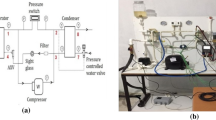Abstract
In this study, therma l performance of two hydrocarbon refrigerants of R290 and R1270 was measured in an attempt to substitute R22. They wer tested in a heat pump bench tester of 1 ton capacity with a hermetic rotary compressor. Water and water/glycol mixture were employed as the secondary heat transfer fluids in the test bench. All tests were conducted under the same external conditions simulating three different air-conditioning and heat pumping conditions. Test results show that the coefficient of performance of these hydrocarbon refrigerants is up to 11.5% higher than that of R22 under all conditions. Refrigeration capacity of R290 is up to 8.2% lower than that of R22 under normal air-conditioning and heat pumping conditions. Under extremely cold temperature conditions, however, the capacity of R290 is 5% higher than that of R22. On the other hand, the capacity of R1270 is similar to that of R22 under all conditions. Compressor discharge temperatures of these hydrocarbons are reduced by 14–31°C as compared to R22. The amount of charge is reduced up to 58% as compared to R22. Overall, these hydrocarbons provide good performance with reasonable energy savings without any environmental problems and thus can be used as long-term alternatives for residential air-conditioning and heat pumping applications.
Similar content being viewed by others
References
United Nations Environmental Programme, Montreal protocol on substances that deplete the ozone layer, Final act, United Nations, New York, NY, USA, (1987).
R. Radermacher and D. Jung, Theoretical analysis of replacement refrigerants for R22 for residential uses, ASHRAE Trans. 99(Part 1) (1993) 333–343.
A. Cavallini, Working fluids for mechanical refrigeration, Int. J. Refrigeration. 19(8) (1996) 485–496.
D. Jung, Y. Song and B. Park, Performance of HCFC22 alternative refrigerants, Int. J. Refrigeration. 23(6) (2000) 466–474.
J. M. Calm and P. A. Domanski, R-22 replacement status, ASHRAE Journal. 46(8) (2004) 29–39.
D. A. Didion and D. B. Bivens, Role of refrigerant mixtures as alternatives to CFCs, Int. J. Refrigeration. 13(3) (1990) 163–175.
Global Environmental Change Report, A brief analysis of the Kyoto protocol, Vol. IX, No. 24 (1997).
N. Cox, Energy comparison of a ground source heat pump using hydrocarbon refrigerants, Proceedings of the 6th IIR Gustav Lorentzen Natural Working Fluids Conference, Glasgow, UK, (2004).
H. Kruse, The state of the art of the hydrocarbon technology in household refrigeration, Proceedings of the Int. Conferences on Ozone Protection Technologies, Washington, DC, (1996) 179–188.
D. Jung, C. Kim, K. Song, and B. Park, Testing of propane/isobutane mixture in domestic refrigerators, Int. J. Refrigeration 23(7) (2000) 517–527.
Int. Energy Agency’s Heat Pump Center, Informative fact sheet: Hydrocarbons as refrigerants in residential heat pumps and air-conditioners, (2002).
I. L. Maclaine-cross and E. Leonardi, Why hydrocarbons save energy? Australian AIRAH Journal 51 (1997) 33–37.
Author information
Authors and Affiliations
Corresponding author
Rights and permissions
About this article
Cite this article
Park, KJ., Jung, D. Performance of R290 and R1270 for R22 applications with evaporator and condenser temperature variation. J Mech Sci Technol 22, 532–537 (2008). https://doi.org/10.1007/s12206-007-1028-3
Received:
Revised:
Accepted:
Published:
Issue Date:
DOI: https://doi.org/10.1007/s12206-007-1028-3




